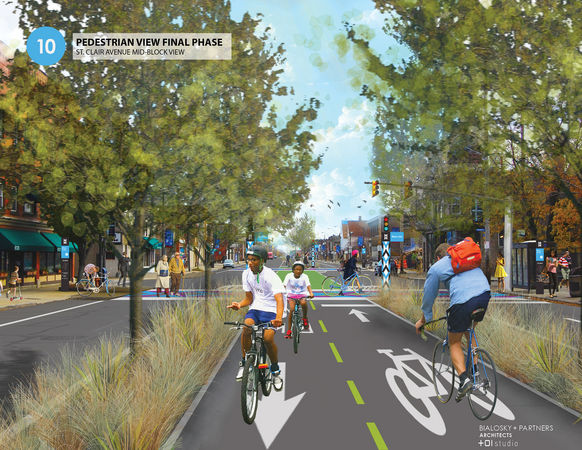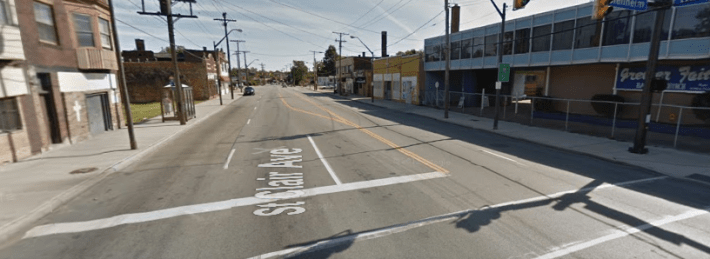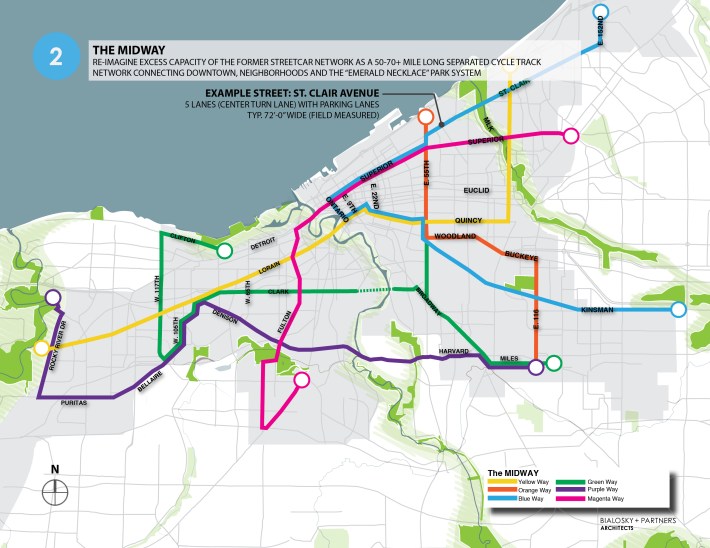
Like many cities in America, Cleveland grew into its own as a streetcar city. In the early part of the last century, hundreds of miles of streetcars connected all corners of the city as well as its inner suburbs. The streets where tracks carried passengers -- Lorain, Superior, Euclid -- were the circulatory system of the city, around which neighborhood life was organized.

But around the middle of the 20th century, streetcars gave way to private cars -- upending this way of life. Many Clevelanders got in their cars and abandoned historic urban neighborhoods at disastrous rates, moving to former farmlands where they could shop in big box stores. Streetcar tracks were mostly paved over and forgotten, leaving extra-wide streets behind. The retail spaces that lined those routes are now pocked with vacancies.
But some local residents see an opportunity to transform these historically significant corridors back into something vital and attractive. They call their plan the Midway -- a proposal to transform former streetcar rights-of-way with landscaped, center-running bike lanes.
"It seems so obvious to me," said Barb Clint, director of community health and advocacy at the YMCA of Greater Cleveland. Clint is also a board member at Bike Cleveland, the city's bike advocacy group. (Disclosure: I'm also on the board of Bike Cleveland and have helped promote the Midway in Cleveland.)
Clint is a veteran of the Cleveland public sector and non-profit scene, and she knows the problems with the city's streets well. "We have these massive streets, with severely low volumes of traffic. They’re not comfortable to walk along, they’re not comfortable to bike along because people are driving so fast," she said. "We can’t preach at people and tell them they should be more physically active if we’re not providing them safe places to do so."
Two years ago, Clint and another Bike Cleveland board member, John McGovern, came up with the first iteration of the Midway plan. The beauty of the streetcar routes is that they're nicely dispersed throughout the city. And in almost all cases, the space is ripe for reuse: Cleveland's streets lack the traffic congestion of larger, growing cities.
Midway advocates think the concept could be realized rather cheaply, with some paint and bollards, and no one would even notice the loss of the lanes, based on informal traffic studies they've conducted.

That's part of what makes the concept so elegant. It can be scaled up or down, depending on the resources available, advocates say. The high-end Midway plan would place the bike lanes inside beautifully landscaped medians. (An auxiliary benefit of this version could be improved storm water management.) The team estimates the full 100-mile buildout could cost as little as $40 million or as much as $150 million, but there hasn't been a formal study yet.
Clint, McGovern and a core group of other advocates, including transportation engineer Melissa Thompson and design associate Ted Ferringer of the firm Bialosky + Partners, have been compiling data and drawings and taking their project on the road to leading institutions. Clint and her team have the backing of Bike Cleveland and have begun seeking support from major institutional players like Cleveland Metroparks and the Northeast Ohio Regional Sewer District.
Perhaps most encouraging is that a local community development organization, St. Clair Superior Development, has seized on the idea for St. Clair Avenue, pictured at the top of this post. The organization has teamed up with the Midway team to apply for a grant from the Kresge Foundation to build a pilot of the first segment. Kresge recently conducted a site visit to consider the proposal.
The next step, according to Clint, is to secure funding to do a full-fledged feasibility and economic study. Meanwhile, the team is developing a website and fine-tuning its presentation in hopes of enticing institutions to pass resolutions of support.
So far, almost all the feedback they've received has been remarkably positive.
"I honestly think if we were to implement the entire network it would be utterly transformative," she said. "This would be an utterly defining attribute for Cleveland."





